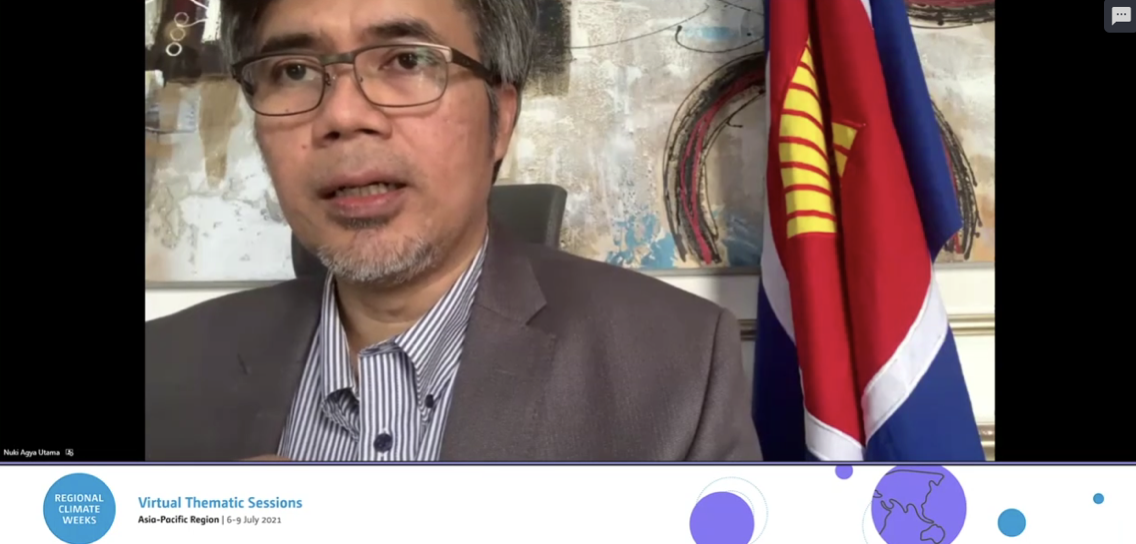Menu
Online, 7 July 2021The 2021 Asia-Pacific Climate Week (APCW) was held virtually on 6-9 July 2021. Dr Nuki Agya Utama, the Executive Director of the ASEAN Centre for Energy (ACE), participated in the 2nd day,” Imagining A Sustainable Energy Future by 2050,” which was organised by United Nations Environment Programme (UNEP). The discussion focused on the realisation of Paris Agreement goals and net‐zero emissions by 2050. Dr Nuki Agya Utama, as one of the panellists, brought forth the energy sector progresses, challenges, and opportunities to pursue Green House Gas (GHG) emission reduction and energy security in ASEAN.

The event started with discussing coal phase-out and energy transition pathways by the United Nations Economic and Social Commission for Asia and the Pacific (UN ESCAP). The key policy recommendations are phasing out fossil fuel subsidies, adopt carbon pricing, renewable energy (RE) support, encourage a shift in investment, move to transformational policies, targets and long-term planning in line with Paris Agreement, clear pathways to enable anticipation of change and avoid more stranded assets and financial support and capacity building.
Nuki described that in line with SDG 7, five of the ASEAN Member States (AMS) had reached 100% electrification, with around 17.7 million households having electricity. However, there are still challenges in Cambodia and Myanmar. According to the energy planning on The 6th ASEAN Energy Outlook (AEO6), ASEAN is projected to have 100% electrification in 2030.
In achieving SDG 7.2: deployment of RE, there are substantial increases in energy demand, which will imply RE from 8% in 2005 to 15% in 2030 and 17% in 2040. According to the ASEAN Plan of Action for Energy Cooperation (APAEC) Target Scenario, RE will increase to 22% in 2030 and 26% in 2040 of the Total Final Energy Consumption (TFEC). In addition, currently, there are around 140 million ASEAN people that are still using traditional biomass.
It is a challenge to switch from conventional biomass to LPG, biogas, and electric stove. Related to SDG 7.3: the improvement of Energy Efficiency (EE), as of 2017, the region had surpassed the 2020 regional target of achieving 21.6% energy intensity reduction. For the financing requirements based on the APAEC scenario, the power sector investment needs to have approximately USD 350 billion, of which 75% comes from RE investment. The scenario also predicts 223 thousand job creation In the RE sector in 2025, and with more robust RE promotion policies, employment will increase up to 300 thousand in 2040.
The APAEC approaches outcome-based strategies on the regional commitment in accelerating climate action. Also critical are people-centred economic approaches, localisation of social-economic concerns and incentives, especially clean cooking to break the silos between sectors. The most important one is to develop a policy and action plan to recover from the covid 19 pandemics.
The development of interconnection in the region will increase grid flexibility and energy security. According to ASEAN Interconnection Masterplan Study (AIMS), interconnection will be the significant transition in Southeast Asia. The region will also focus on increasing Variable Renewable Energy (VRE) as the APAEC mandated to install power capacity up to 35% of RE in 2025. With this vast potential of RE development and job creation, coal power plants are expected to be pushed down. However, studies are still needed to determine the region timeline in achieving net zero emission.
–
SNF
